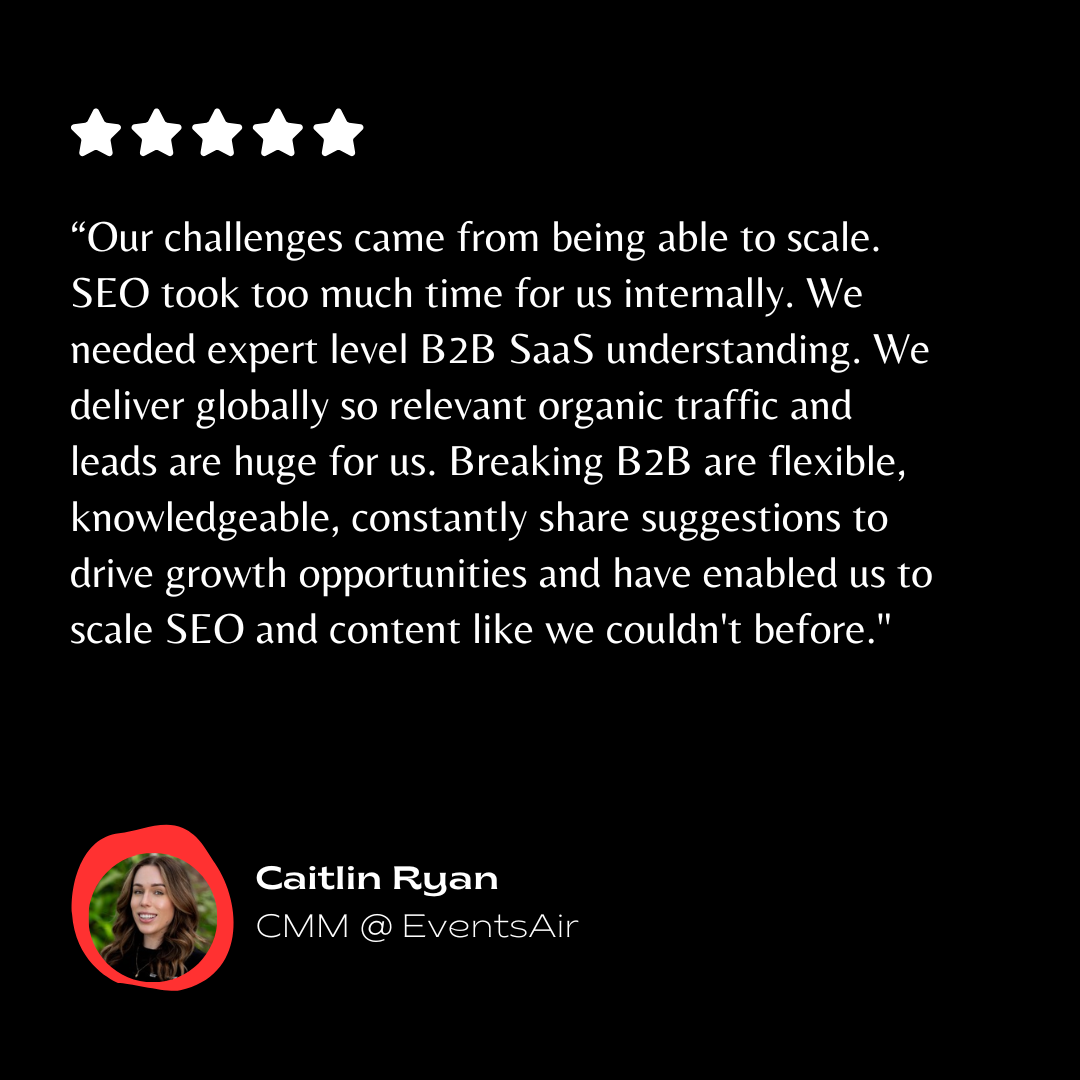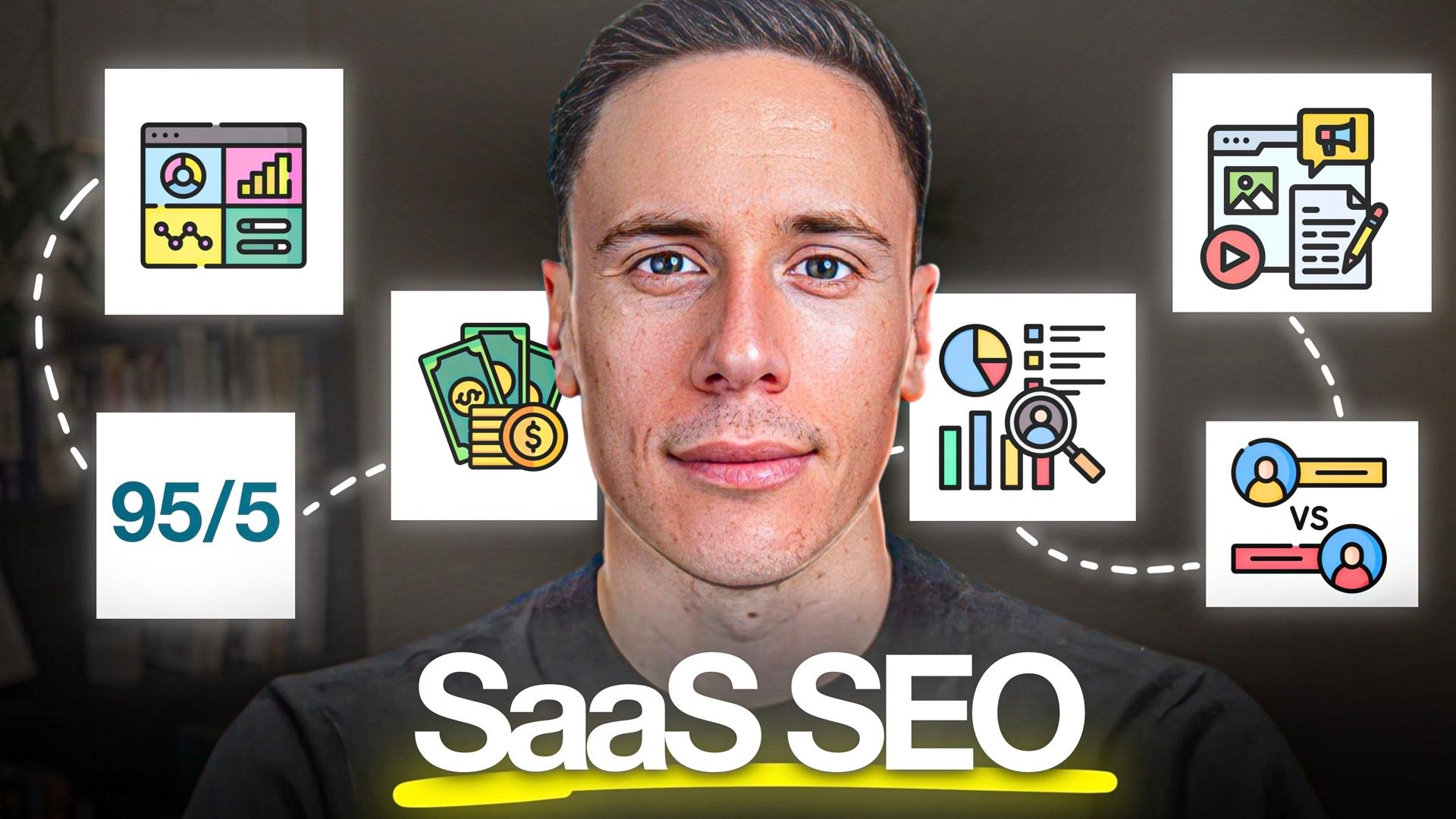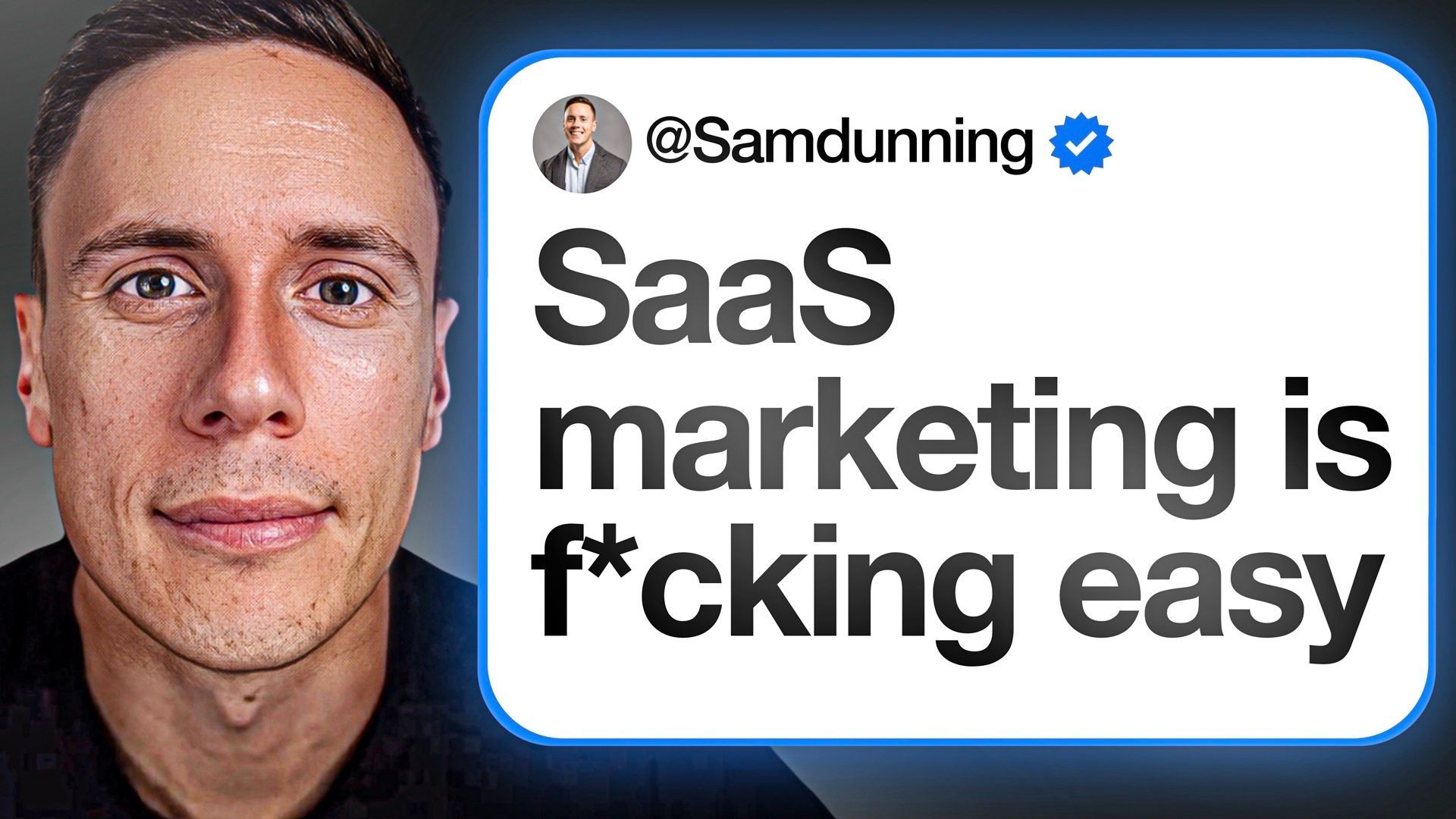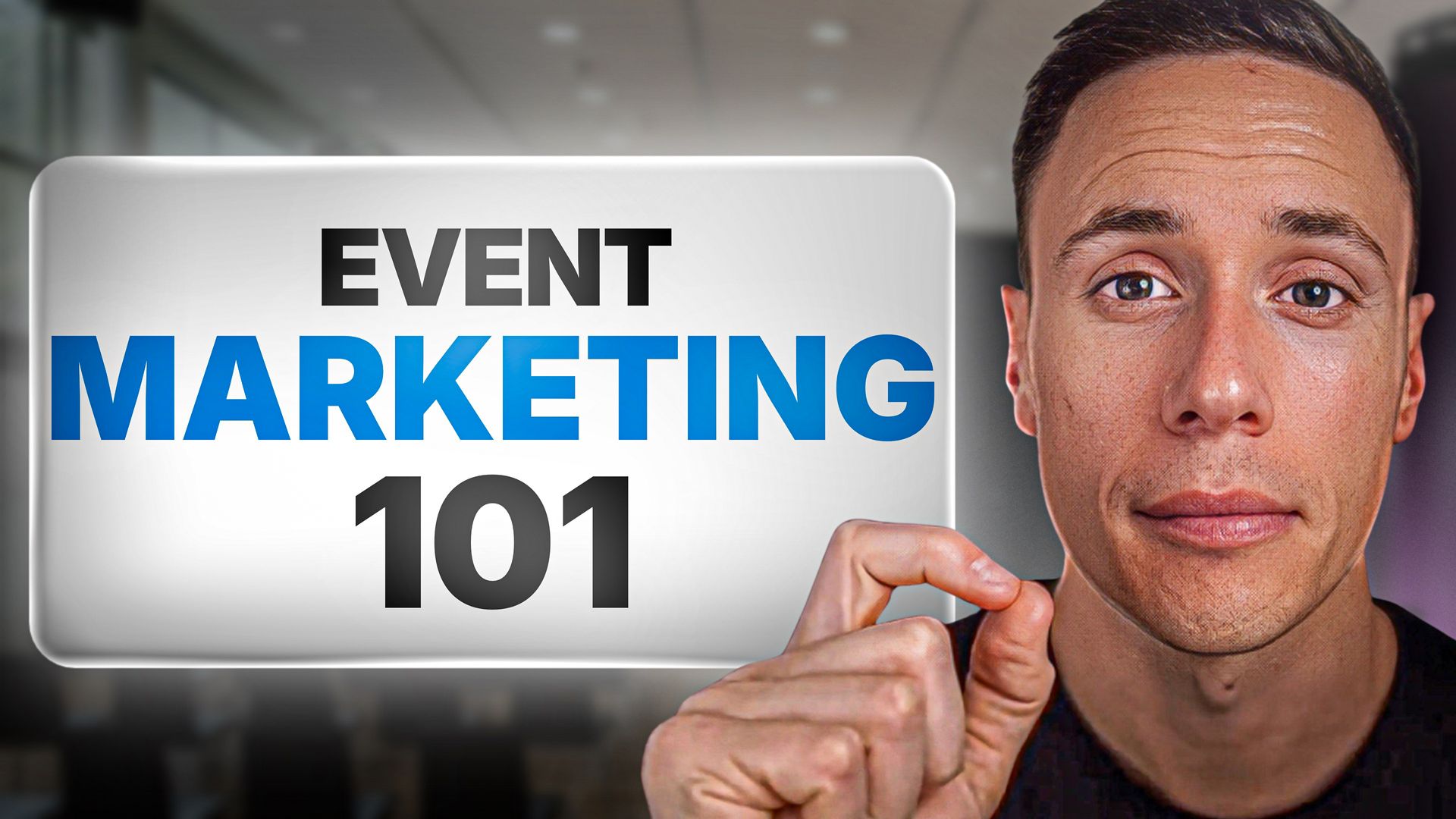Table of Contents
Ready To Grow Organic Pipeline & Revenue?
See if we can scale your organic pipeline from SEO as quick as 90 days.
Quick Summary
Why Most B2B SaaS Sales Funnels Break (and How to Fix Yours)
Most B2B SaaS companies don’t have a lead problem, they have a funnel problem. The structure is outdated. The content misses intent. And the journey doesn't reflect how today’s buyers actually evaluate software.
Modern SaaS buyers want proof of value, not hand-holding. They expect fast answers, a frictionless path to try or buy, and content that speaks to their exact role and needs. If your funnel doesn’t deliver that, they won’t stick around.
In this
Breaking B2B guide, we’ll break down exactly how to build a B2B SaaS sales funnel that works, from top-of-funnel strategy to post-sale retention. You’ll learn how to align content with buyer intent, reduce friction across the journey, and turn more prospects into paying, long-term customers.
Why Listen to Us?
At Breaking B2B, we’ve scaled organic visibility for
50+ B2B SaaS and tech companies. Our proven keyword research methodology has generated millions in pipeline value through strategic content targeting. We understand the nuances of B2B SaaS buyer behavior and search patterns that drive real business results. For more practical insights on B2B SEO success, feel free to visit our
blog.

What Is a B2B SaaS Sales Funnel?
A B2B SaaS sales funnel is more than a path to purchase. It’s a system built to drive recurring revenue. Unlike traditional software funnels focused on one-time deals, SaaS funnels are optimized for signups, activation, and long-term retention.
This model reflects how SaaS is sold today: free trials, self-serve entry points, and the pressure to prove value fast. A strong funnel connects marketing, sales, and customer success around a single goal, which is turning interest into impact.
Most B2B SaaS funnels follow seven key stages:
- Awareness
- Lead capture
- Qualification
- Trial activation
- Conversion
- Onboarding
- Expansion
Each stage requires a different strategy, set of metrics, and optimization levers. Get it right, and your funnel becomes a growth engine.
Why You Need a B2B SaaS Sales Funnel
SaaS growth isn’t just about generating leads. It’s about turning pipeline into predictable revenue. Without a structured funnel, you’re left guessing at conversion points, wasting budget, and losing buyers along the way.
Here’s why building a high-performing B2B SaaS sales funnel is non-negotiable:
- Predictable revenue, not guesswork:
A well-structured funnel makes MRR forecasting accurate, often within 5%. That means smarter hiring, cleaner board reporting, and stronger investor confidence. When you can show how leads move through the funnel and turn into revenue, you stop flying blind.
- Lower CAC with better efficiency:
Optimized funnels reduce acquisition costs by 30–60% by improving targeting, speeding up sales cycles, and lifting conversion rates. The result is more efficient growth and freed-up budget for things that move the needle, like product or expansion.
- Better trial-to-paid conversion:
Most SaaS companies can spend over $1,000 to get someone into a free trial. But without a funnel designed to activate and convert, that money goes to waste. A structured funnel ensures that users don’t just sign up, they see value fast and stick around to pay.
Bottom line: If your funnel isn’t built to scale, your revenue won’t either.
How to Build a High-Converting B2B SaaS Sales Funnel
1. Define Your Ideal Customer Profile and SaaS Buyer Personas
A high-converting funnel starts with clarity on who you’re selling to. If you skip this step, your messaging, targeting, and content will miss the mark, and so will your conversions.
Start by building a clear Ideal Customer Profile (ICP). Look at your best customers—those with strong retention, fast time-to-value, and high expansion potential. Map patterns across company size, industry, tech stack, and growth stage. Many successful SaaS companies land in the $10M–$100M revenue range, but your sweet spot might be more niche. Know it.
Then build out detailed buyer personas for everyone involved in the decision:
- Technical evaluators want integrations, security, and a clear proof of concept.
- Economic buyers care about ROI, total cost, and strategic alignment.
- End users look for usability, efficiency gains, and smoother workflows.
Each group has different questions and your funnel needs to answer all of them.
Use tools like Clearbit, ZoomInfo, and LinkedIn Sales Navigator to fill in the gaps. You’ll get valuable intel on technographics, funding rounds, and org structure. That’s the kind of data that shapes high-precision targeting and sharper funnel messaging.
When your personas are accurate and mapped to buying behavior, everything downstream performs better. This includes ads, emails, CTAs, and conversions.
For a deeper dive into targeting buyer personas and refining your messaging tactics, check out Sam’s Breaking B2B podcast episode Weird B2B Messaging Strategies (And More To Scale Pipeline in 2025). It’s an excellent resource for aligning your sales funnel with the complex dynamics of SaaS buying committees.
2. Build a Funnel That Matches How SaaS Buyers Search and Evaluate
A scalable SaaS funnel isn’t built on assumptions. It’s built on systems that reflect how buyers actually research, try, and adopt software. The average B2B SaaS buyer conducts about 12 searches before engaging with a vendor. So, if your content doesn’t show up during that journey, you're already out of the running.
Here’s how to create a content engine that turns awareness into trials, and trials into revenue:
- Build content clusters around buyer needs:
Start with pillar pages that target broad, high-level terms like “sales enablement software” or “workflow automation tools.” Then support them with focused content that answers specific use-case questions, covers integration details, or walks through implementation steps. This structure builds topical authority and supports every stage of the buyer journey.
- Target keywords that signal buying intent:
Go beyond traffic. Focus on high-intent terms like
“best [category] tools,” “[competitor] alternatives,” or
“how to implement [your solution].” These keywords often convert
3–5x better than general informational queries because they attract buyers who are ready to act.
- Create honest comparison content:
Don’t shy away from naming competitors. B2B buyers
expect to see detailed comparisons, such as pricing breakdowns, feature gaps, and implementation tradeoffs. If you don’t provide it, they’ll find it elsewhere. Balanced, transparent comparisons build trust and position your product as the smarter choice.
- Use the right tools to find high-converting opportunities:
Tools like
Ahrefs, SEMrush,
and Moz help you uncover long-tail keywords tied to specific use cases, roles, and integrations. These terms usually face less competition and attract leads deeper in the funnel, making them more likely to convert into trials or demos.
This is how top SaaS companies build sustainable inbound engines. By showing up early, answering real questions, and making the next step obvious.
Watch Sam break down how to capture high-intent search traffic through content clusters, commercial keyword targeting, and competitor comparisons in the Breaking B2B podcast:
3. Turn Interest Into Action with Targeted SaaS Lead Magnets
Traffic is great, but it doesn’t pay the bills. Once you’ve captured attention through B2B SEO, the next move is turning that interest into pipeline. That’s where lead magnets come in.
The best SaaS lead magnets solve specific, high-friction problems for your buyers. They show your value before a sales pitch ever lands in the inbox.
Match lead magnets to the right persona and funnel stage:
- Technical buyers want implementation guides, API documentation, and integration checklists.
- Economic buyers look for
ROI calculators, cost-benefit templates, and business case frameworks.
- End users respond to best-practice playbooks, usability walkthroughs, and productivity tips.
Proven high-converting formats include:
- ROI calculators and business case templates
- Integration checklists and technical documentation
- Competitive comparison charts and industry benchmark reports
- Security assessments and compliance frameworks
- Feature configuration guides and onboarding walkthroughs
Interactive formats, like calculators, self-assessments, or comparison tools, often drive 2x more engagement than static PDFs. They also deliver richer insights to your sales team, revealing buying intent before the first touchpoint.
Great lead magnets don’t just capture leads, they qualify them. Build them with that goal in mind.
To learn more about creating effective lead magnets, watch Sam's deep dive on How to Create an Awesome Lead Magnet.
4. Maximize Trial Conversion and Nail Onboarding
In SaaS, trials make or break your funnel. Most B2B buyers want to use the product before they buy it. If your trial doesn’t deliver value fast, they won’t stick around.
Here’s how to turn more trials into paying customers:
- Guide users to the “aha” moment fast:
Trials typically last 14 days. That’s time to show what matters. Prioritize features that solve the core problem your product is built for.
- Use guided onboarding, not guesswork:
Structure the first user experience. Walk users through key milestones in a logical order. Users who complete activation sequences convert up to
60% more often.
- Personalize based on behavior:
Track what users engage with. Exploring integrations? Show them API docs. Checking out analytics? Surface ROI templates. Relevant content increases conversion, plain and simple.
- Score and act on trial activity:
Monitor logins, feature usage, and time in-app. Use this data to flag sales-ready accounts and trigger timely outreach from your team.
- Re-engage drop-offs:
Trials don’t always go smoothly. Set up triggers for inactivity and use targeted emails, in-app messages, or even quick check-in calls to get users back on track.
Use tools like Pendo, Mixpanel, or Amplitude to power this process. These platforms give you the data to personalize experiences, surface intent, and improve trial conversion at scale.
The trial is your product’s pitch. Make it count.
To learn more about optimizing trial conversion and user onboarding, watch this indepth analysis.
5. Implement Sales-Driven Nurturing Sequences
B2B SaaS sales cycles aren’t short. Nurturing keeps your solution top-of-mind while guiding prospects from interest to close. The key is combining automated content with well-timed sales outreach based on real behavior and not generic timelines.
Here’s how to build sequences that drive momentum:
- Segment by behavior and funnel stage:
One-size-fits-all emails don’t work. Tailor sequences by trial engagement, company size, and evaluation signals.
- For active users - Serve feature-specific content.
- For stalled accounts - Resurface value props and use cases.
Segmented campaigns consistently drive higher open and click-through rates. - Blend your content with strategic outreach:
- Implementation guides
- Case studies
- Integration playbooks
- ROI frameworks
Then layer in personalized touches from sales to keep the momentum high. - Trigger outreach based on real actions:
- Pricing page visits? Send ROI calculators.
- Docs or integrations explored? Follow up with technical resources.
Automated, action-based messaging converts better because it shows you’re paying attention. - Use the right tools to scale it: Platforms like HubSpot, Marketo, and Pardot let you build behavior-based workflows, track engagement, score leads, and prompt timely sales follow-ups. Your team focuses on warm leads instead of cold ones.
When marketing and sales align on timing, content, and context, your nurture sequences stop feeling like automation and start accelerating deals.
6. Convert and Onboard New SaaS Customers the Right Way
Turning a trial into a paid account is great, but retention starts with onboarding. If users don’t see value quickly, they churn. The best SaaS funnels don’t just convert, they set up customers to stick.
Here’s how to get it right:
- Streamline your trial-to-paid upgrade flow:
Most SaaS products convert a small fraction of trial users. That’s often a funnel issue, not a product issue. Clear in-app CTAs, personalized upgrade prompts, and fast sales follow-up can significantly lift conversion rates.
- Fix your pricing page:
Don’t just list plans. Use your pricing page to handle objections and build trust. Add customer quotes, feature comparisons, security badges, and implementation timelines. When buyers feel confident, they convert faster.
- Gather onboarding intel during the sale:
Use progressive profiling or sales calls to capture what success looks like for the customer:
- What problem are they solving?
- What does “value” look like?
- What integrations are critical?
Pass this info to your customer success team so onboarding starts with context and not guesswork.
- Design onboarding for early wins:
Map a 30-day path to value. Set clear milestones, surface key features, and guide users through their “why now.” When customers see impact early, they’re more likely to renew, upgrade, and advocate.
Conversion is just the beginning. Great onboarding turns new users into long-term customers—and fuels the rest of your funnel.
7. Measure and Optimize Your Funnel Like a Growth Engine
A high-performing B2B SaaS funnel isn’t “set and forget.” It’s a system you constantly test, tweak, and improve. Without data, you’re guessing. With it, you’re compounding growth month after month.
Start by setting up end-to-end funnel analytics. Track how prospects move from first touch to trial, from trial to paid, and from onboarding to retention. The best SaaS teams don’t optimize based on what they think works, they follow the numbers.
Here are the metrics that matter most:
- Trial-to-paid conversion rate and
time-to-conversion
- CAC vs. LTV (and how that ratio improves over time)
- Monthly Recurring Revenue (MRR) and
churn
- Sales cycle length and
deal velocity
- Customer satisfaction and
NPS
Go deeper with cohort analysis. See how different customer segments behave post-conversion. Which ICPs expand fastest? Where does retention drop? These insights shape both your content and your product strategy.
Finally, test everything. A/B your landing pages. Experiment with onboarding sequences. Refine nurturing emails. Even small conversion wins (1% here, 3% there) add up to major revenue over time when you’re running a scalable funnel.
If you’re not measuring, you’re not optimizing. And if you’re not optimizing, your competitors are.
Advanced B2B SaaS Funnel Best Practices
Once your funnel is up and running, the next step is scaling it with a smarter strategy. These advanced practices help you drive compounding growth, shorten sales cycles, and turn more customers into long-term revenue.
Leverage Product-Led Growth (PLG)
Today’s buyers want to try before they talk to sales. A product-led funnel lets prospects experience real value early while capturing usage data for sales follow-up. PLG companies grow up to 30% faster than sales-led teams because users convert themselves. Focus on seamless trials, fast “aha” moments, and scalable onboarding that supports both self-serve and sales-assisted paths.
Layer in Account-Based Marketing (ABM)
Big SaaS deals don’t close through broad campaigns. For high-value accounts, align sales and marketing around a shared target list and run persona-level messaging across email, ads, and outbound. ABM can drive 208% more revenue than traditional approaches when done right. Use intent data, firmographics, and role-based pain points to deliver content that moves entire buying committees forward.
Optimize for Recurring Revenue, Not Just Signups
SaaS is a retention game. Your funnel should be built for MRR, CLV, and Net Revenue Retention (NRR) from day one. That means weaving upsell paths, expansion plays, and customer success enablement into onboarding, nurture, and post-sale experiences. Revenue doesn’t stop at the close, it compounds after it.
Use Multi-Touch Attribution to Guide Spend
Most SaaS buyers engage across 6–12 touchpoints before converting. If you’re only measuring last-click, you’re under-investing in what actually drives pipeline. Multi-touch attribution gives you a clearer view of the full journey, from SEO to retargeting to sales outreach, so you can scale what works and cut what doesn’t.
These aren’t tactics for later. They’re multipliers for SaaS teams ready to move beyond patchwork growth and build a funnel that performs quarter after quarter.
Time to Build Reliable SaaS Funnels
Effective B2B SaaS sales funnels transform scattered sales efforts into systematic customer acquisition engines. By combining strategic SEO, optimized trial experiences, and sophisticated nurturing sequences, you create predictable revenue growth that scales with your business.
The most successful SaaS companies treat funnel optimization as an ongoing process rather than a one-time project. Continuous testing, measurement, and refinement enable sustainable growth that adapts to changing market conditions and customer expectations.
Ready to build SaaS funnels that convert prospects into customers?
Book a call with Breaking B2B today.







